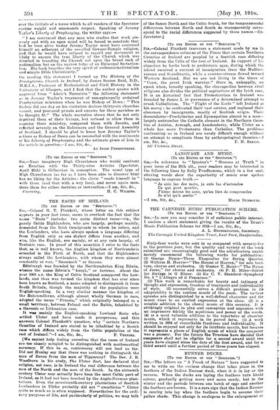THE RACES OF IRELAND.
ITo THE EDITOR OP THE " SPECTATOR."7 SIR,—Colonel G. T. Plunkett, whose letter on this subject appears in your last issue, seems to overlook the fact that the name "Soots" includes two quite distinct races—viz., the purely Celtic Highlanders, who are largely, perhaps mainly, descended from the Irish immigrants to whom he refers, and the Lowlanders, who have always spoken a language differing from English only as one dialect differs from another, and who, like the English, are mainly, or at any rate largely, of Teutonic race. In proof of this assertion I refer to the facts that, as is well known, the Anglian kingdom of Northumbria extended to the Firth of Forth, and that the Highlanders always called the Lowlanders, with whom they were almost constantly at war, " Sassenach " or Saxons.
Edinburgh was founded by the Northumbrian King Edwin, whence the name Edwin's " burgh," or fortress. About the year 1000 A.D. the King of Celtic Scotland conquered the Low- lands, and thus was formed the kingdom that has ever since been known as Scotland, a name adopted to distinguish it from South Britain, though the majority of the population were English-speaking. In a very similar manner the kingdom of the Hohenzollerns, although almost -Wholly German in TORO, adopted the name " Prussia," which originally belonged to a small territory, between Poland and the Baltic, inhabited by
• Slavonic or Lithuanian race.
It was mainly the Englieh-speaking- Lowland Scots who settled Ulster and have made it prosperous, and this answers Colonel Plunkett's question, why " certain Northern Counties of Ireland are stated to be inhabited by a Scotch race which differs widely from the Celtic population of the rest of Ireland."—I am, Sir, &e., F. Vitromes. [We cannot help feeling ourselves that the races of Ireland are too olosely mingled to be distinguished with mathematical accuracy. If this be so, controversy will not lead us far. Did not Huxley say that there was nothing to distinguish the man of Devon from the man of Tipperary? The Rev. J. B. Woodburn in his study, The Ulster Scot, has declared that religion, not race, is in Ireland the real difference between the men at the North and the men of the South. In the sixteenth century Ulster may actually have been the most Celtic part of Ireland, suit had not been touched by the Anglo-Norman plan- tations. Even the seventeenth-century plantations of Scottish Lowlanders in Hider probably did not "uncelticize" Ulster quite so much as is often supposed. Nevertheless for the ordi- nary purposes of life, and particularly of polities, we may talk of the Saxon North and the Celtic South, for the temperamental differences between North and South do transparently corre- spond to the racial differences suggested by those names.—En. Spectator.]






































 Previous page
Previous page